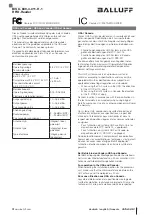
NOTE: If the patient can sit easily, then the
sling can be positioned in the same manner
as if the patient was seated in a chair. See
“
To lift from a Chair
”
section.
WARNING: To avoid the patient swinging
excessively during lifting, the lift strap
should be as vertical as possible,
immediately prior to the lift.
21
Fig. 11
Fig. 12
3) Position the Maxi Sky
1000
directly over the
patient.
4) Using the handset, lower the spreader bar and
connect the sling shoulder strap loops, taking care
not to lower the frame onto the patient.
5) The straps must be brought under the thighs. This
may involve lifting one leg at a time, and may
mean lowering the frame a little more.
When lifting from the bed, some operators prefer
to connect the leg strap loops first. This in
particular applies to patients with large thighs. To
use this method, raise the hip and knee into
maximum flexion, and hook up the leg strap
loops.
6) Ensure that all four points of the sling are
securely attached to the frame, then lift the
patient using the handset, positioning him/her
comfortably for transfer.
Proceed with the patient transfer to a chair as in
section “To lift from a Chair”, or place the patient
onto a bed, (reversing the above procedure), by
moving and then lowering the patient into the desired
position.
When the patient’s body weight is fully supported,
detach the leg strap loops, then the shoulder
connections.
Move the spreader bar away before removing the
sling from under the patient.
To lift a Patient from a chair
The lifting techniques described here, and repre-
sented in the images in following pages, can be used
for seated patients regardless of where they may be
seated (e.g. on the edge of a bed, in a chair, wheel-
chair or similar).
1) Place the sling around the patient so that the base
of his/her spine is covered, and the head support
area of the sling is behind the head.
Pull each leg strap under the thigh so that it
emerges on the inside of the thigh (Fig. 13).
How to Use the Maxi Sky
1000
Ceiling Lift
















































